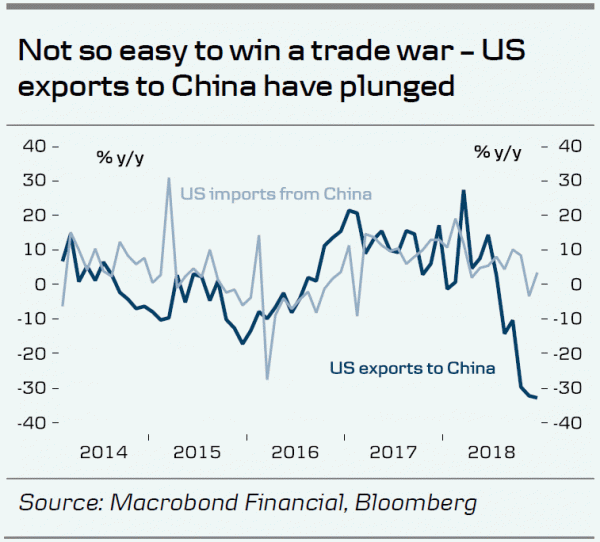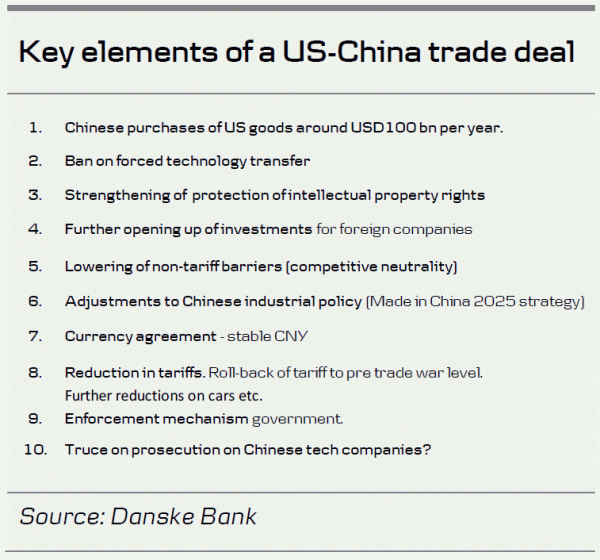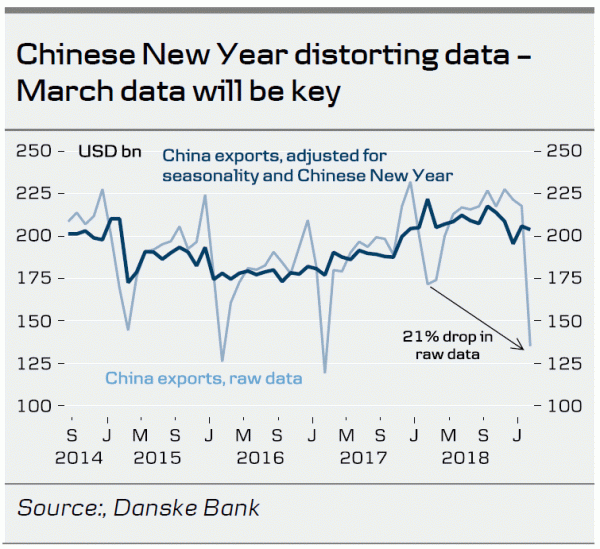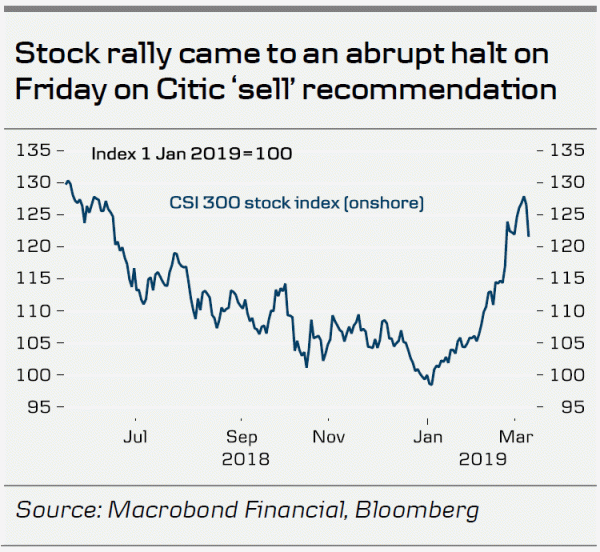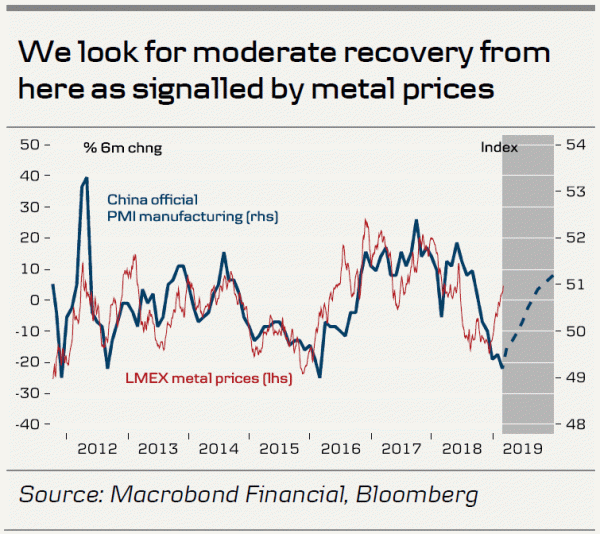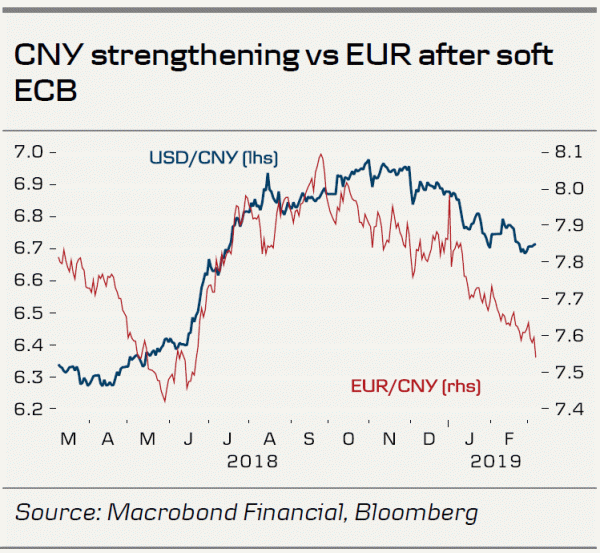- Trade deal to face hurdles close to the finish line, but deal is still coming
- NPC lowers growth target to 6-6½% and announces large-scale tax cuts
- Chinese stocks take a beating after sharp rally and Citic sell recommendation
We are back to the Friday release of the China Weekly Letter. Early next week we will publish our ‘Postcard from China’ summarising the key takeaways from our trip to Shanghai, Hangzhou and Hong Kong last week.
Trade talks reaching the most difficult points
The US-China trade talks are getting close to the finish line and it is time to deal with the most difficult points. New York Times (NYT), 7 March, reports that Chinese officials are becoming wary of a quick deal and that agreeing on enforcement is the main hurdle. According to NYT Michael Pillsbury from the Hudson Institute (a China hawk close to the White House) said that ‘there may be the need for another round of talks before the signing summit’ . US ambassador in Beijing Terry Branstad told the Wall Street Journal , 8 March, that ‘a date hasn’t been finalized’ for a meeting between Xi and Trump and that sufficient progress had to be made for both parts to feel confident that a deal can be signed. ‘We’re not there yet, but we’re closer than we’ve been for a long time’ Branstad told the WSJ.
According to sources close to the talks China demands a roll back of the majority of the tariffs to finalise a deal and would in return be willing to make further cuts in tariffs on goods like autos and agriculture, see Yahoo finance 4 March.
US trade data for December showed that the US-China trade deficit rose to a new record in 2018 of USD419bn from USD375bn in 2017. Interestingly US exports to China have plunged since the trade war started whereas US imports from China are broadly flat (see chart).
Comment . We rarely see ‘high stake’ deals be made without a break-down at some point during negotiations. We may be in for some more mixed news towards the end of the negotiations as both sides will aim to get the best possible deal . We have noticed that Trump has started to keep saying ‘if we make a deal’ every time he says it will be a great deal. His advisers may have told him not to seem too eager to make a deal as it weakens their negotiation position. However, the bottom line is that Trump needs a deal for his election campaign. A failure would send markets sharply lower and hurt the economy, including US farmers who are key voters in major swing states. It may be a while before we get a date for the Xi-Trump summit as both sides needs to be sure a summit ends in a deal. This could make markets nervous. When we get a date we can be quite confident a deal will be made (see table for an overview of what a trade agreement will likely include).
The sharp drop in US exports to China shows that it is not the higher tariff measures that matter for the direct effect on exports. China has only put tariffs on US goods worth USD50bn. Instead, it has been the quantitative measures of simply stopping purchases of certain US goods, such as soy beans, that China has used to hit back at the US.
NPC lowers growth target, and that is actually a good thing
The National People’s Congress kicked off Tuesday with Premier Li Keqiang reading out the so-called Work Report to the close to 3000 delegates. The key elements were:
- Growth target lowered to 6-6½% from 6½% (as widely expected). Li was frank about the growth challenges saying ‘we must be fully prepared for a tough struggle’.
- Fiscal easing through reduction in VAT rates. For manufacturing companies the VAT rate is cut from 16% to 13% and for construction, transportation and other industries the rate is cut from 10% to 9%. The tax cut and other reductions in costs to social insurance should lead to a reduction in business costs of close to 2% of GDP. It is partly compensated by belt-tightening in other areas, though.
- Further opening-up measures. NPC is set to approve a new Foreign Investment Law, which among other things increases protection of intellectual property rights, bans forced technology transfer, and stresses that foreign and domestic companies should be treated equally, except in prohibited industries: China Daily, 31 January, and China.org, 3 March.
- Still a strong focus on upgrading the manufacturing sector and investments in high-tech – but the label ‘Made in China 2025’ is gone.
- Measures to improve education. China will take more measures to improve education in rural areas and expand vocational training.
Comment. We see the lowering of the growth target as positive. It illustrates China’s prioritisation of ‘quality over quantity’ and balancing short-term risks to the economy with long-term sustainability in growth. The fiscal easing was generally expected and adds to other stimulus measures. More important for the long-term outlook is China’s focus on technology, education, more competition from opening-up and measures to support the private sector. The work report lists a range of measures to underpin so-called ‘market entities’, the Chinese expression for private sector.
Stock markets take a hit on Friday, exports plunge
After a strong bull run this year, equities hit the wall on Friday with a drop of 4%; the biggest daily drop in five months. Sell recommendations from some of the biggest Chinese securities companies on two major financial companies (China Securities and PICC) seemed to trigger the decline, see Bloomberg 8 March. The recommendations were seen as endorsed by the authorities, as the exuberance in markets is deemed a potential threat to financial stability (as was the case in the 2015 stock market bubble). Weak export data earlier this week also worked to temper the rising optimism over the Chinese economy.
Comment. A correction in the stock market was overdue after a 25% rally in 10 weeks. We see more downside in the short term but are positive on a 6-9 month horizon as we look for a Chinese recovery and lower risk premia on the back of a trade deal. The export data for February were distorted by the Chinese New Year and do not look as bad when correcting for this (see top chart).
Other China news of the week
CNY strengthened further versus the EUR following this week’s softer-than-expected move by the ECB. The trend is still towards a stronger CNY (see chart).
Italy is set to be the first G7 country to endorse Belt and Road Initiative, see FT 6 March. The Italian move has drawn sharp criticism from Washington. The Chinese Foreign Minister Wang Yi urged the EU to stay ‘independent’ in dealings with China after the US warning, see SCMP 8 March.




